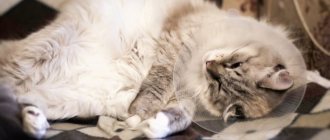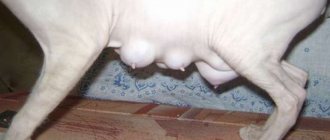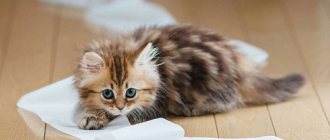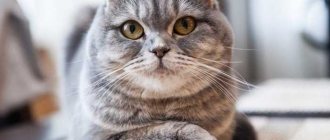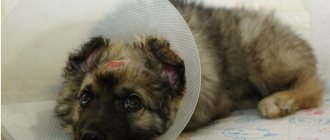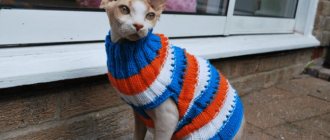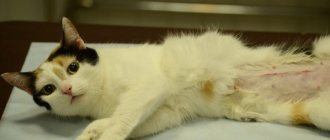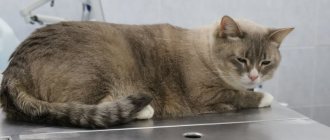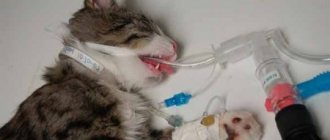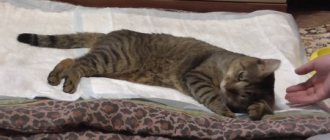8723Administration
In order to properly care for the animal during rehabilitation after surgery, you need to know how to treat the suture after sterilization of the cat. Postoperative care, unlike surgery, takes longer than sterilization itself. The owner of the animal will have to care for the sterilized pet for at least two weeks.
The operation is performed either for medical reasons or at the request of the owner. The veterinary procedure lasts from half an hour to two hours. It is better to treat the seam the first time in a clinic under the supervision of a veterinarian, then at home.
How long does it take for a cat to wear off anesthesia after sterilization?
The cat's condition after surgery varies greatly depending on the type of anesthesia. After inhalation (gas) anesthesia, the pet is returned to its owners in full consciousness. Cats recover very quickly after intravenous administration of propofol. It takes them about half an hour to wake up. Therefore, in this section I will talk mainly about intramuscular anesthesia. Usually this is a combination of a muscle relaxant (xylazine/domitor and their analogues) and zoletil. Some doctors use a drug that takes the cat out of medicated sleep. Antisedan removes the domitor effect, and the animal can walk within 30 minutes after the injection.
Cat after sterilization using intramuscular anesthesia
Not all experts yet have an anti-sedan available. Some people simply save money on it (“and so it will wake up”). Others follow the lead of the owners, who find it more convenient to take home a “rag” rather than a meowing cat that is trying to get out of the carrier. All this is unacceptable!
Find out in advance what kind of anesthesia your cat will be given. If after sterilization she is unconscious, it is better to leave her in the hospital under observation for several hours.
Not every clinic has equipment for inhalation anesthesia.
How to help your cat recover from anesthesia
Let's consider a situation in which you were given a cat under deep anesthesia. She already twitches her ear if you blow into it, but she can’t blink or walk yet. Paws and ears are cold to the touch. This is due to the fact that body temperature during anesthesia decreases by several degrees. Unfortunately, not all doctors use a heating pad during surgery. Therefore, the cat may experience noticeable trembling - it is simply very cold. And the animal needs to be warmed.
If the cat's eyes are open and she is not blinking, then care should be taken to moisturize the cornea. It’s easier to apply tetracycline ointment and “glue” the eyelids together. Cornergel is well suited for moisturizing. You can drip regular saline solution. Often veterinarians will apply eye ointment themselves during surgery, ask your doctor about this. Owners of brachycephalic dogs (Persians, exotics) should be especially attentive. Their bulging eyes are prone to drying out and causing keratitis.
Cats do not close their eyes while under anesthesia
If you hold a cat in your arms, it should lie belly down. One hand under the chest, the other under the butt. To prevent the tongue from sticking and blocking the airway, it is pulled out of the mouth to the side. When the cat is able to retract it on her own, she will do it. Before this, you can gently moisten the tongue with water so that it does not dry out.
Even if the cat was on a fasting diet before surgery, it may vomit during recovery from anesthesia. To prevent her from choking, her head should be turned to one side or hang down freely. You cannot cradle your pet in your arms like a baby doll (back down).
At home, the cat should be placed on its side, in a warm place on the floor (a blanket near the radiator). It is strictly forbidden to place a sleeping cat on a bed or sofa. On the bed - only when the animal can climb there on its own. The cat may not understand where it is and fall awkwardly down.
If the cat was “packed” into a carrier at the clinic, then it is best to leave it there. Place it on the floor and open the door so that your pet can come out whenever she wants.
The carrier should be spacious and rigid, not fabric
Possible complications and solutions to emerging problems
Not in all cases, the recovery period after surgery goes smoothly. Sometimes it is accompanied by complications that can appear for various reasons: due to untimely or improper treatment of the suture, the characteristics of the pet’s body, advanced age, the qualifications of the veterinarian performing the procedure, violation of the rules of asepsis and antisepsis, etc.
Possible complications and ways to eliminate them:
Non-disappearing or increasing painful sensations, accompanied by constant plaintive meowing. Don't try to numb the pain with painkillers.
It is important to find out why your tailed pet is experiencing pain in the operated area and take appropriate action to correct the problem. If several days have passed since the surgical intervention and the pain has not subsided, it is recommended to show the animal to a veterinarian.
Seroma
Fluid accumulates at the incision site due to the presence of an open area or gap in the subcutaneous fat layer due to incomplete suturing, licking, or increased motor activity of the cat. When they fill with inflammatory fluid, lumps form under the suture line. If lymphorrhea is suspected, differential diagnosis is required to exclude an abscess. Usually this convex formation disappears on its own as the fluid that forms it is reabsorbed by the tissues of the pet’s body. Sometimes it requires draining and suturing.
- Suppuration as a result of infection entering the wound. This complication often appears when the cat has a tendency to allergies, hypercortisolism, diabetes, viral immunodeficiency and blood cancer. If your tailed pet develops symptoms of an abscess, it should be shown to a veterinarian, who will install drainage and prescribe appropriate treatment for the four-legged patient. With an extensive infection process, the wound will not heal on its own. The only way out of this situation is to remove and reapply sutures after excision of necrotic skin areas under anesthesia.
- Bleeding into the abdominal cavity, accompanied by weakness, loss of interest in food, anemia of the mucous membranes, breathing problems, and abdominal pain. If you suspect bleeding into the abdominal cavity, you need to take the cat to the veterinary clinic as quickly as possible. Delay can lead to the death of your pet. Using an ultrasound, the veterinarian will detect the presence of free fluid in the tailed patient. If the diagnosis is confirmed, he will be prescribed immediate surgical intervention, the purpose of which is to open the abdominal cavity and apply a new ligature. Treatment involves intravenous medications to maintain blood pressure. Extensive blood loss requires a blood transfusion.
How does a cat behave after anesthesia?
When the cat starts to get up, it may stagger like a drunk and crash into walls and objects. There is no point in holding her in place by force. It is better to limit your pet's movements within one room.
In order for the cat to calmly come to its senses, you need to remove external stimuli as much as possible. When recovering from anesthesia, even the calmest cat can become aggressive or panic. Need to exclude:
- Society of other animals;
- Loud, sharp sounds;
- The light is too bright;
- Drafts, cold;
- Violence in any form (being held in arms, dragged from place to place).
When waking up, the cat does not understand well what is happening around. She feels weak (her legs can't hold her up, her head is spinning). Instinctively, the animal will try to defend itself or run away - just in case. Do not allow children to pet your pet when she recovers from anesthesia, and be careful yourself. Without recognizing your hands, the seemingly sleeping beauty can rise up like a candle and awkwardly fall back.
Sometimes owners are frightened by the vocal exercises of a cat that is just waking up from anesthesia. This may be a hoarse meow, a howling growl or hissing.
Residual effects from anesthesia may last up to a day (usually much less), after which the cat will behave as usual. A short video showing a cat after anesthesia:
When can you feed a cat after sterilization?
The sterilization operation is preceded by an 8-10-hour fasting diet. Therefore, when everything is over, the owners cannot wait to feed their pet. However, there is no need to rush: after anesthesia, vomiting is possible.
The doctor should tell you how many hours after sterilization you can feed your cat. Recommendations will vary depending on the type of anesthesia used during surgery. On average, you can offer food through:
- Inhalation anesthesia – 1-2 hours;
- Intravenous anesthesia with propofol - after 2-3 hours;
- Intramuscular anesthesia (Domitor + Zoletil) – after 4-8 hours.
First, the cat is given a small portion of its usual food. If she doesn’t vomit, you can give her more. If you burp, wait a few more hours. Vomiting (one-time) is considered normal within 24 hours after surgery.
Prolonged fasting for cats is neither desirable nor justified! The main criterion is regaining consciousness and restoration of motor functions. If a cat asks to eat, you don’t need to go on a starvation diet for 12-24 hours - this is exactly the advice I’ve seen on specialized forums.
Water can be made available immediately; as a rule, cats do not show interest in it. You cannot force anything into a cat! If he wants, he will drink.
Cornish Rex in a post-operative blanket
What to feed a cat after sterilization and anesthesia
The main mistake of loving owners is the desire to pamper an operated cat with something special. A sudden change in diet can cause digestive upset. There is no need to feed your cat differently after sterilization than before surgery.
If the kitty ate natural food, then the only recommendation is to give the food warm, and not from the refrigerator. You should also avoid products that are strong.
If the cat has been eating dry food, then it is offered when the animal comes to its senses after anesthesia. There is no need to soak the food: the cat had her ovaries removed, not her teeth. However, in addition to crackers, owners often regularly provide canned food from the same company. Then wet food will be an ideal option.
There is no need to run to buy food for sterilized cats immediately after surgery. Hormonal levels will change gradually over 1-2 months. You need to switch to a new food smoothly, after the blanket is removed and the cat has fully recovered.
After sterilization, cats tend to become overweight, but hormonal changes take time
How long to wear a blanket after sterilizing a cat
The main condition after sterilization is to prevent the cat from licking the seam. To do this, use either an Elizabethan collar or a fabric blanket. The duration of wearing these “accessories” depends on what kind of stitch was applied. You need to focus on the recommendations of the operating surgeon and the condition of the suture, because healing in different animals can occur at different speeds.
If a cosmetic suture was applied (absorbable threads are all inside, the skin is perfectly connected end-to-end), then the blanket is worn for about a week (7 days). I am a reinsurer, so I recommend wearing a blanket for 10 days after surgery.
This is what a cosmetic seam looks like after sterilizing a cat. All the threads are inside.
If the seams are removable, then the blanket is worn until the seams are removed, plus one day after, so that the holes heal quietly after the threads are removed. Usually it is 10-12 days.
This is what a cosmetic stitch looks like on days 10-12
On the first day after surgery, the cat shows little interest in the suture. The worst concern is on the 3-4th day: the shaved fur begins to grow back, and the healing seam begins to itch. The cat may try to lick its tummy through the fabric.
Some cats calmly accept the “clothes” and do not try to take them off. Others roll around and tear at it with teeth and claws until they get rid of it. In this case, it is preferable to wear a collar instead of or together with a blanket.
Instead of blankets, you can wear more beautiful clothes
When a cat first wakes up after surgery, it may back away or walk backwards. Or she completely refuses to get up and walk, as if paralyzed. As soon as you remove the blanket, these frightening symptoms disappear. Check that the blanket is not tied too tightly, and the cat will soon get used to it.
Cats hate blankets, but you have to be patient
Do I need to remove stitches at all?
Here everything depends on the characteristics of the suture material used during the operation. Today, veterinarians all over the world are trying to use varieties that dissolve on their own. But this doesn't always happen.
In addition, even material that is “digested” by the animal’s body is not immediately absorbed. The stitches left on the animal's skin are disturbing and irritating. Therefore, the cat will constantly itch and chew its belly. All this may well lead to the development of an inflammatory reaction.
This will save you from many problems in the future. Please note that this only applies to external seams. Sutures placed on the peritoneum dissolve perfectly.
How to treat a seam after sterilizing a cat
Modern standards of veterinary medicine do not require any suture treatment after sterilization of a cat. The tiny cosmetic suture heals on its own; it is not even necessary to remove the blanket within a week after the operation. In the clinic, as a rule, a special spray is applied to the seam and shaved belly:
- Dark gray leather - it was Aluminum spray (Alu-spray, Second Skin);
- Bright green – Terramycin spray;
- Purple – Chemi spray.
The surgical field and suture are treated with Aluminum spray
The seam should be processed only if it is external and removable - the thread knots are visible. And only if the treatments were prescribed by your surgeon. The point is to prevent the threads from sticking to the skin and to each other. Good non-aggressive antiseptics are aqueous Chlorhexidine 0.05% or Miramistin. Using a cotton pad soaked in the solution, carefully remove all crusts and discharge and separate the threads. It is enough to treat once a day. Be sure to remove any stuck-on hair that accumulates in the seam area.
This is what the outer seams look like. Even if absorbable material is used, it is better to remove the threads on the 12th day
Do not use alcohol or drying solutions – Fukortsin, brilliant green – to treat seams. Iodine - only diluted with water 1:1. You should not use any ointments; the seam should be clean and dry.
Removable sutures are removed at 10-12 days. This is a painless and quick procedure. After removing the stitches, the doctor will once again treat the skin with an antiseptic spray and put on a blanket. You can take off your clothes the next day.
Errors when processing seams
Beginner breeders make many common mistakes. Some of them are relatively harmless, while others can lead to very serious consequences:
- We have already indirectly pointed out this above - it is strictly forbidden to fill the seam itself with iodine or brilliant green, as this leads to the development of chemical burns to the tissue.
- The seams must be handled gently and carefully, avoiding strong and rough pressure. In the most “advanced” cases, rough treatment can even lead to suture separation, which will require repeated surgery!
- Another serious mistake concerns the use of ointments. When applying such preparations, they should be spread in a thin layer, not thickly!
- In addition, the stitches should never be covered with bandages that are too tight to prevent air flow. Neglecting this rule can lead to the development of deadly anaerobic infections!
Treatment after cat sterilization
If a young and healthy cat was operated on, then no drug treatment is required after sterilization. On the day of surgery, the doctor gives a single injection of a long-acting antibiotic and pain reliever.
If maximum sterility is maintained after surgery, antibiotics are not needed. A clean room, careful preparation of the animal, high-quality consumables - only under such conditions can the doctor not fear a suture infection.
When it comes to pain relief, veterinarians may have different opinions. The vast majority do not consider it necessary to prescribe analgesics. This is due to the small size of the suture on the abdominal wall. Abroad, such medications are prescribed for 3-5 days after surgery.
If your cat wears a collar, you don't need to wear a blanket.
If your doctor considers the use of antibiotics or analgesics necessary, follow his instructions! Only he knows how the operation went, what condition the uterus was in and other nuances. Intensive treatment is prescribed to cats in case of pyometra (purulent inflammation of the uterus); this operation cannot be equated to sterilization of a healthy cat.
Mistakes of inexperienced owners
Here is a list of critical mistakes that are most often made by inexperienced seams with an alcohol tincture of iodine or brilliant green. First of all, it hurts. Secondly, such a concentration of antiseptic compounds does not lead to anything good. More precisely, they simply burn the tissue, which is why a chemical burn also develops right at the postoperative suture, in addition to other “joys”. Accordingly, the regeneration time increases significantly.
Owners who believe that the seam (provided it looks good) does not need to be processed at all are also mistaken. Like, “it will heal like that.” We must not forget that the environment is rarely sterile, and therefore the wound canal can be contaminated with pathogenic or conditionally pathogenic microflora at any time. This phenomenon will certainly lead to the development of purulent inflammation.
Some breeders vigorously rub the seam during processing, which is also unacceptable. Rough processing can, firstly, introduce an infection into the seam, and secondly, such actions slow down the regeneration process.
You cannot thickly coat the seams with ointments, you cannot “tightly” cover it with tight bandages. There must be air access to the wound channel! Otherwise, anaerobic infections may develop, which are fatal to the health of the animal (and often lead to death).
